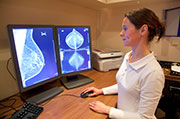

Even with recent strides in breast cancer treatment, a woman’s chances of surviving the disease still partly depend on early detection, a new study says.
The study of nearly 174,000 Dutch breast cancer patients found that survival rates improved between 1999 and 2012 — and that included women with more advanced cancer.
Still, women’s survival odds were best when their tumors were caught early, the researchers reported in the Oct. 6 issue of the medical journal BMJ.
“The general prospects for a woman diagnosed with breast cancer in the Western world are very good,” said lead researcher Dr. Madeleine Tilanus-Linthorst, of Erasmus University Medical Center in the Netherlands.
Her team found that among women diagnosed with breast cancer between 2006 and 2012, the five-year survival rate was 88 percent. That compared with 83 percent among women diagnosed with the cancer between 1999 and 2005, the study said.
The brighter outlook extended to women with more advanced cancer. Among those with larger tumors — more than 2 inches across — the research revealed that the five-year survival rate rose from 63 percent to 73 percent.
However, the smaller a woman’s tumor at diagnosis, the better the outlook. Of women diagnosed in more recent years, nearly all survived at least five years if their tumor was caught when it was less than three-quarters of an inch across, the study found.
In fact, their five-year survival rates were comparable to those of an average woman their age who’d never been diagnosed with breast cancer, the study showed.
“Catching the cancer early is still highly important,” Tilanus-Linthorst said.
Of the women diagnosed between 2006 and 2012, she noted, 65 percent had their tumors caught when they were still less than three-quarters of inch in size.
Dr. Harold Burstein cowrote an editorial published with the study. “The cancers caught these days are smaller and better-behaved when you look at them under a microscope,” said Burstein, an oncologist at the Dana-Farber Cancer Institute in Boston.
“And this study shows that even with the treatment advances of recent years, tumor size still matters,” he said.
That might sound unsurprising, Burstein noted. But the substantial improvements in breast cancer treatment in the past decade or so have raised the question: Is early detection as important as it used to be?
Those treatment advances include “targeted” drugs such as Herceptin that zero in on specific abnormal proteins found in certain breast tumors; wider use of hormonal therapies that lower the risk of a breast cancer recurrence; and better chemotherapy regimens, according to the study.
In this study, women diagnosed with breast cancer in more recent years were more likely to receive those treatments. They were also more likely to receive “breast conserving” surgery — where only the tumor and some surrounding tissue are removed — and less likely to undergo a mastectomy, the study found.
Even with those therapy changes, though, tumor size at diagnosis remained a key factor in a woman’s outlook, the researchers said.
And that, Burstein said, underscores the value of mammography screening.
The study did not actually look at the effects of breast cancer screening, Burstein pointed out. “But,” he said, “I think this indirectly supports mammography screening.”
That’s important, he said, because the benefits of mammography screening have been debated in recent years, especially when it comes to women younger than 50.
In the United States, mammography guidelines vary. The American Cancer Society and some other groups suggest yearly mammograms starting at age 40.
However, the U.S. Preventive Services Task Force (USPSTF) suggests that women begin screening at age 50, and continue every two years. Women in their 40s are advised to weigh the pros and cons of screening.
The “cons” include false-positive mammography results that lead to invasive testing — as well as unnecessary treatment of tiny tumors that would never progress to threaten a woman’s life, according to the USPSTF.
The “pros,” Burstein noted, include catching and treating tiny tumors that would have threatened a woman’s life.
More information
The American Cancer Society has more on treating breast cancer.
Source: HealthDay
Copyright © 2024 HealthDay. All rights reserved.

Leave a Reply